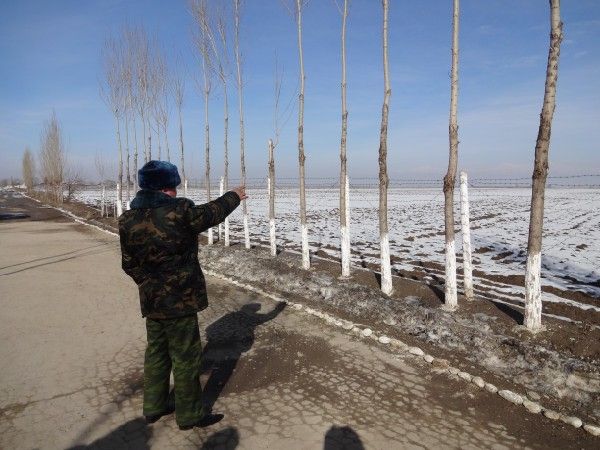OSH, Kyrgyzstan (TCA) — In the southwest of Kyrgyzstan, with its important Uzbek minority and arguable borders there is a potential cause for confrontation with Uzbekistan and Tajikistan. At stake are precious irrigation water and mineral resources.
Disputes over grazing rights for the cattle breeders on the Kyrgyz side and water supplies for petty farmers in the plains, which are Uzbek territory, regularly lead to deadly shootouts. There is little that authorities on either side can do, since both countries dispute the course of the border line.
The fence was put up in the winter of 1999 to 2000 following a series of deadly bomb attacks in Tashkent, attributed to and claimed by the so-called Islamic Movement of Uzbekistan (IMU) activists of which were suspected to have crossed the border from hideouts on Tajik and/or Kyrgyz territory. The main trouble was that the course of the border lines, especially that with Kyrgyzstan, was hard to determine since various Soviet maps gave different courses. Most of the fence as it stands today, running along the southeastern flank of the Ferghana Valley, is located way into what Bishkek considers Kyrgyz land.
Tearing old wounds open
Meanwhile, a prolongation of the fence to the north, near the town of Osh in the central-west of Kyrgyzstan, is under construction. The fence in the Tuya-Moyun area in southern Osh, near the Kerkidon reservoir in Kyrgyzstan was not just to trigger skirmishes between local inhabitants but it threatened, and still threatens, tearing old wounds open, for the problem has deep roots. When in the early XIX Century present-day Kyrgyzstan fell to the newly founded Khanate of Kokand (located in the central-south of the Ferghana Valley, now part of Uzbekistan), bitter rivalry escalated between the Sart, as the Uzbeks were called at the time, and the mountain tribes inhabiting the lands to their east. The repression by the Khanate resulted in the extermination of the Kypchak tribes, originating from southern Siberia, and their Kyrgyz neighbors who were further up in the mountains and only survived thanks to their adherence to the Russian Empire.
But the ethnic rivalry persisted throughout Soviet dominion, and flared up in a violent manner in the early summer of 1989. What sparked the terrible massacres in and around Osh, in which the number of killed amounted to 320, was a row over a cotton processing combine on disputed land. The follow-up was the formation of an Uzbek political movement under the name Adalat that started to send petitions to the Kremlin with the request to grant Osh the status of an autonomous “Uzbek” oblast of Osh. The objective was the incorporation of Osh territory into the Republic of Uzbekistan. Later the matter was settled with the Soviet authorities restoring successfully the order.
From house to house
Though tension mounted significantly following the start of the fence’s construction, the situation remained more or less under control for another half decade. But on May 14, 2005, a day after the Andijan massacre in which Uzbek troops killed and wounded hundreds in what had started as a peaceful demonstration, Uzbek locals seized control of Qorasuv, a town on the border with Kyrgyzstan, driving away state officials. Angry crowds set government buildings on fire and attacked the mayor and his staff. Both countries’ governments intervened to avoid further escalation.
The next, far more serious spark came on June 7, 2010, with the murder in broad daylight in downtown Osh of Aybek Mirsidikov, nicknamed Black Aybek, one of the local leading drug traffic bosses – an ethnic Uzbek. Suspicion fell on a Kyrgyz narco-gang to which both Kurmanbek Bakiyev and the mayor of Osh Melis Myrzakmatov were thought to be connected. The gang’s leader was a certain Kamchi Kolbayev, who was held by police later in the month, interrogated but never brought to justice. The following day, shootouts occurred between the gangs of two mobsters, one Kyrgyz and the other Uzbek, over control of the Kara-Suu bazaar right on the border, leaving dozens killed and more injured. What followed was even worse, as both Kyrgyz and Uzbek groups of youngsters went from house to house, raping, killing, looting, smashing and burning at random until security forces moved in with a shoot-to-kill order for anyone caught red-handed. It took two days to restore calm, leaving between 300 and 400 deaths according to official records and well over a thousand according to eye witnesses.
A lot more at stake
The latest standoff began in the third week of March this year, when Uzbek armoured vehicles and armed troops were stationed near the Kyrgyz town of Kerben with the aim to “protect” the Ala Buka water reservoir, located on Kyrgyz territory claimed by Uzbekistan and on which Uzbek farmers to the north depend for the irrigation of their lands. Bishkek responded by sending a similar armed force to the spot. On March 28, military were withdrawn from both sides, but the cause of the dispute was not solved.
If the region of Osh remains the most dangerous hotbed of the trouble confronting Kyrgyzstan’s outskirts, the region of Batken remains the scene of the most frequent clashes. Both areas see frequent confrontation between civil groups using hand weapons and hunting rifles, and border guards using heavier firearms.
But there is more to Batken, which could lead to conflicts with a lot more at stake than just irrigation water. The area is home to important deposits of gold, copper, tin, zinc, wolfram, cobalt and other metals. The first two gold deposits have been under detailed exploration since 2014 and production is expected to start this year. Moreover, to the south uranium fields have been identified, stretching into Tajikistan. To both cash-strapped countries, billions worth in assets like these are worth a much heavier fight than just human comfort – which is why keeping an eye on future relations looks crucial.



